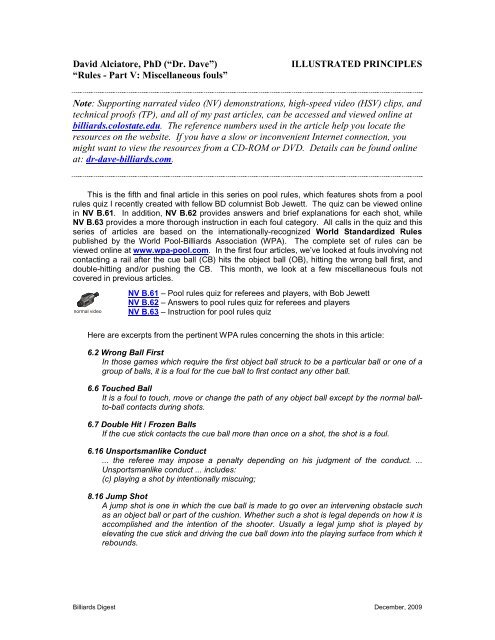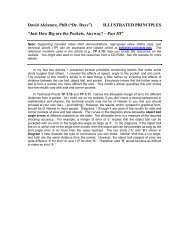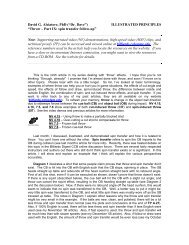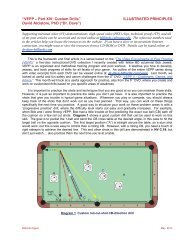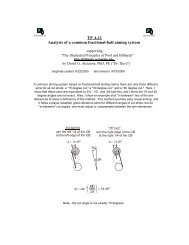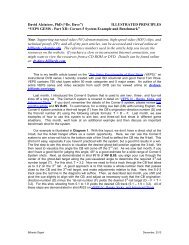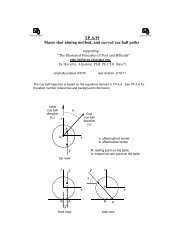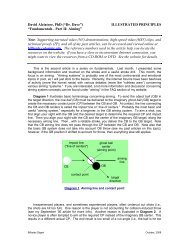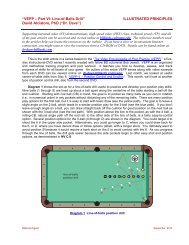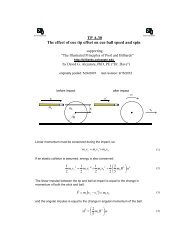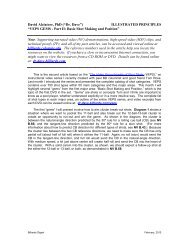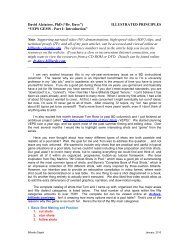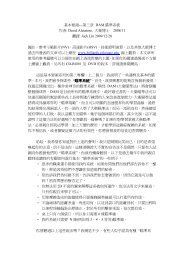Rules - Part V: miscellaneous fouls - Illustrated Principles of Pool ...
Rules - Part V: miscellaneous fouls - Illustrated Principles of Pool ...
Rules - Part V: miscellaneous fouls - Illustrated Principles of Pool ...
Create successful ePaper yourself
Turn your PDF publications into a flip-book with our unique Google optimized e-Paper software.
David Alciatore, PhD (“Dr. Dave”) ILLUSTRATED PRINCIPLES<br />
“<strong>Rules</strong> - <strong>Part</strong> V: Miscellaneous <strong>fouls</strong>”<br />
Note: Supporting narrated video (NV) demonstrations, high-speed video (HSV) clips, and<br />
technical pro<strong>of</strong>s (TP), and all <strong>of</strong> my past articles, can be accessed and viewed online at<br />
billiards.colostate.edu. The reference numbers used in the article help you locate the<br />
resources on the website. If you have a slow or inconvenient Internet connection, you<br />
might want to view the resources from a CD-ROM or DVD. Details can be found online<br />
at: dr-dave-billiards.com.<br />
This is the fifth and final article in this series on pool rules, which features shots from a pool<br />
rules quiz I recently created with fellow BD columnist Bob Jewett. The quiz can be viewed online<br />
in NV B.61. In addition, NV B.62 provides answers and brief explanations for each shot, while<br />
NV B.63 provides a more thorough instruction in each foul category. All calls in the quiz and this<br />
series <strong>of</strong> articles are based on the internationally-recognized World Standardized <strong>Rules</strong><br />
published by the World <strong>Pool</strong>-Billiards Association (WPA). The complete set <strong>of</strong> rules can be<br />
viewed online at www.wpa-pool.co m.<br />
In the first four articles, we’ve looked at <strong>fouls</strong> involving not<br />
contacting a rail after the cue ball (CB) hits the object ball (OB), hitting the wrong ball first, and<br />
double-hitting and/or pushing the CB. This month, we look at a few <strong>miscellaneous</strong> <strong>fouls</strong> not<br />
covered in previous articles.<br />
normal video<br />
NV B.61 – <strong>Pool</strong> rules quiz for referees and players, with Bob Jewett<br />
NV B.62 – Answers to pool rules quiz for referees and players<br />
NV B.63 – Instruction for pool rules quiz<br />
Here are excerpts from the pertinent WPA rules concerning the shots in this article:<br />
6.2 Wrong Ball First<br />
In those games which require the first object ball struck to be a particular ball or one <strong>of</strong> a<br />
group <strong>of</strong> balls, it is a foul for the cue ball to first contact any other ball.<br />
6.6 Touched Ball<br />
It is a foul to touch, move or change the path <strong>of</strong> any object ball except by the normal ballto-ball<br />
contacts during shots.<br />
6.7 Double Hit / Frozen Balls<br />
If the cue stick contacts the cue ball more than once on a shot, the shot is a foul.<br />
6.16 Unsportsmanlike Conduct<br />
... the referee may impose a penalty depending on his judgment <strong>of</strong> the conduct. ...<br />
Unsportsmanlike conduct ... includes:<br />
(c) playing a shot by intentionally miscuing;<br />
8.16 Jump Shot<br />
A jump shot is one in which the cue ball is made to go over an intervening obstacle such<br />
as an object ball or part <strong>of</strong> the cushion. Whether such a shot is legal depends on how it is<br />
accomplished and the intention <strong>of</strong> the shooter. Usually a legal jump shot is played by<br />
elevating the cue stick and driving the cue ball down into the playing surface from which it<br />
rebounds.<br />
Billiards Digest December, 2009
8.18 Miscue<br />
A miscue occurs when the cue tip slides <strong>of</strong>f the cue ball possibly due to a contact that is<br />
too eccentric or to insufficient chalk on the tip. Although some miscues involve contact <strong>of</strong><br />
the side <strong>of</strong> the cue stick with the cue ball, unless such contact is clearly visible, it is<br />
assumed not to have occurred. A scoop shot, in which the cue tip contacts the playing<br />
surface and the cue ball at the same time and this causes the cue ball to rise <strong>of</strong>f the<br />
cloth, is treated like a miscue.<br />
Diagram 1 shows example where an obstacle ball is bumped accidentally with the cue or<br />
bridge hand during a shot. The standard rule in this situation is “all-ball <strong>fouls</strong>” (see WPA Rule<br />
6.6). In this case, you are not allowed to come in contact with any ball before, during, or after a<br />
shot. The only exception is the cue tip hitting the CB during a single-hit, legal stroke. A common<br />
variation on this rule in many tournaments and leagues is called “CB <strong>fouls</strong> only.” In this case, the<br />
illegal contact applies only to the CB. An exception is when any touched or moved ball affects<br />
the shot by directly or indirectly changing the path <strong>of</strong> any ball in motion, in which case the<br />
unintentional contact is a foul. In shot 10 (the 1-ball shot in Diagram 1), the bridge hand<br />
unintentionally touches and moves the 4-ball during the shot. If playing under “all-ball <strong>fouls</strong>,” this<br />
would, by definition, be a foul. But if playing under “CB <strong>fouls</strong> only,” this shot would be fair,<br />
because the 4-ball never comes into play (i.e., it doesn’t any moving ball). Your opponent has the<br />
option to reposition any unintentionally moved balls to their original locations, but there is no foul.<br />
In shot 65, however, the CB hits the 5-ball after the 5-ball is unintentionally moved during the<br />
shot. So even if you are playing under “CB <strong>fouls</strong> only,” this shot would be a foul, because the 5ball<br />
affects the CB’s motion.<br />
shot “10”<br />
(fair)<br />
1<br />
4<br />
4<br />
ball moved<br />
accidentally with<br />
bridge hand<br />
CB hits ball<br />
accidentally<br />
moved<br />
shot “65”<br />
(foul)<br />
Billiards Digest December, 2009<br />
5 5<br />
Diagram 1 Accidentally touched ball<br />
Diagram 2 shows two “scoop” shots, where the CB is jumped over a ball by either hitting very<br />
low on the ball, or as the result <strong>of</strong> a miscue. In shot 12 (the 2-ball shot), the game is 9-ball, so we<br />
must contact the 2-ball first (per WPA Rule 6.2). Here, a “scoop” shot is being employed to jump<br />
over the 3-ball. Per WPA rules 8.16 and 8.18, this is a foul. In fact, because <strong>of</strong> the obvious intent<br />
is to scoop the CB, the foul could be ruled as unsportsmanlike conduct as well (per WPA <strong>Rules</strong><br />
6.16 and 8.18). This can result in a stiffer penalty than an ordinary foul, per the discretion <strong>of</strong> the<br />
referee. As shown in the super-slow-motion clips in NV B.63-part 6 (see also: HSV B.2), a scoop<br />
shot doesn’t always involve a miscue or double hit. If the cue tip slides along the cloth and/or hits<br />
2
the CB and table at the same time, the CB is launched into the air with a single non-miscue hit<br />
from the tip. Nevertheless, an intentional scoop is still a foul.<br />
high-speed video<br />
2<br />
shot “82”<br />
(fair)<br />
3<br />
intentional “scoop”<br />
jump shot<br />
Diagram 2<br />
HSV B.2 – Illegal "scoop" jump shots<br />
Billiards Digest December, 2009<br />
1<br />
shot “12”<br />
(foul)<br />
unintentional miscue “scoop” shot,<br />
with the CB hitting the 1-ball before clearing it<br />
“Scoop” shots<br />
Shot 82 (the 1-ball shot) in Diagram 2 shows an unintentional scoop. In this example, there<br />
is no reason to believe a player intended to jump over the 1-ball, because the 1-ball-9-ball<br />
combination is the obvious (and easiest) option, resulting in a win. Also, if you entirely clear the<br />
1-ball, the shot is a foul because the 9-ball would then be contacted first (per WPA Rule 6.2).<br />
Therefore, any scoop here is probably unintentional and would not be ruled as a foul ... provided<br />
the CB touches the 1-ball while airborne.<br />
Diagram 3 shows a shot where a miscue results in a foul whether or not the miscue was<br />
intentional or not. The 1-ball is frozen to the rail and the CB is frozen to the 1-ball. There is no<br />
reasonable legal shot on the 1-ball, but the CB can be kissed <strong>of</strong>f the 1-ball with right English for<br />
the billiard shot on the 9-ball for the win, as per the blue path in the diagram (see HSV B.28).<br />
However, the billiard shot isn’t easy; and if you miss, you will likely lose the game. Here, a<br />
knowledgeable and devious player might decide to intentionally miscue, hoping the opponent or<br />
referee might judge the miscue as unintentional, and therefore not a foul. Most miscues do<br />
involve double hits (see HSV B.36), but an unintentional miscue is not a foul unless a double hit<br />
is “clearly visible” (per WPA <strong>Rules</strong> 6.7 and 8.18).<br />
1<br />
9
high-speed video<br />
1<br />
double-hit<br />
miscue path<br />
shot “99”<br />
(foul)<br />
Diagram 3<br />
possible<br />
intended<br />
path<br />
Double-hit and/or intentional miscue<br />
HSV B.28 – Frozen-ball kiss, miscue, and push shots and <strong>fouls</strong><br />
HSV B.36 – Various miscues with double-hit rule interpretation<br />
NV B.63 – part 4 shows various versions <strong>of</strong> the shot in Diagram 3, with different outcomes.<br />
The shots are also shown in super-slow-motion so you can see what is happening more clearly.<br />
In shot 99, the 1-ball, is “herded” into the pocket. This can occur only with multiple hits on the<br />
CB, as shown in the super-slow-motion clip. Here, based on the motion <strong>of</strong> the balls, an<br />
experienced referee can confidently judge that the miscue resulted in a double hit. In fact, if the<br />
referee thinks the shooter was intentionally miscuing, hoping the foul wouldn’t be called, he or<br />
she could rule the shot as unsportsmanlike conduct, which can come with a stiffer penalty than<br />
ball-in-hand (e.g., loss <strong>of</strong> game or the match, per WPA <strong>Rules</strong> 6.16 and 8.18). In this example, it<br />
doesn’t really matter for the game, because the double-hit foul will result in ball-in-hand with the<br />
9-ball hanger. However, the referee would also have the right to issue an even stronger penalty<br />
(e.g., loss <strong>of</strong> match) if it is obvious that the miscue was intentional. It might seem odd that a<br />
referee could be asked to judge the intent <strong>of</strong> a player, but these “gray areas” exist in every sport,<br />
and pool is no exception. A good analogy is a personal foul in football, where the referee must<br />
judge whether or not there is malicious intent to know what penalty is appropriate.<br />
You can view demonstrations and explanations <strong>of</strong> all <strong>of</strong> the shots in this article (and many<br />
other related shots) in parts 4 and 6 <strong>of</strong> NV B.63. The videos include the appropriate ruling (fair or<br />
foul) and the reason behind each ruling. Be sure to watch the videos online. The super-slowmotion<br />
clips included really help visually reinforce the topics and examples covered.<br />
Well, I hope you have enjoyed and benefitted from my series <strong>of</strong> articles dealing with pool<br />
rules. Please encourage all <strong>of</strong> your pool-playing friends, teammates, league members, and<br />
referees to take the quiz and view the instructional videos online. If people had a better<br />
understanding <strong>of</strong> all <strong>of</strong> the rules and how they are applied, there might be fewer “differences <strong>of</strong><br />
opinion” during league night.<br />
Good luck with your game,<br />
Dr. Dave<br />
Billiards Digest December, 2009<br />
9
PS:<br />
• If you want to refer to any <strong>of</strong> my previous articles and resources, you can access them<br />
online at billiards.colostate.edu.<br />
• I know other authors and I tend to use lots <strong>of</strong> terminology (e.g., squirt, throw, stun, impact<br />
line, etc.), and I know not all readers are totally familiar with these terms. If you ever<br />
come across a word or phrase you don’t fully understand, please refer to the online<br />
glossary on my website.<br />
• I want to thank Jim Valasina. He graciously pro<strong>of</strong>-reads my articles every month to help<br />
find errors and make suggestions. My article quality is better as a result <strong>of</strong> his efforts.<br />
Thanks again Jim!<br />
Dr. Dave is author <strong>of</strong> the book, DVD, and CD-ROM: “The <strong>Illustrated</strong> <strong>Principles</strong> <strong>of</strong> <strong>Pool</strong><br />
and Billiards,” and the DVD: “High-speed Video Magic.”<br />
Billiards Digest December, 2009


